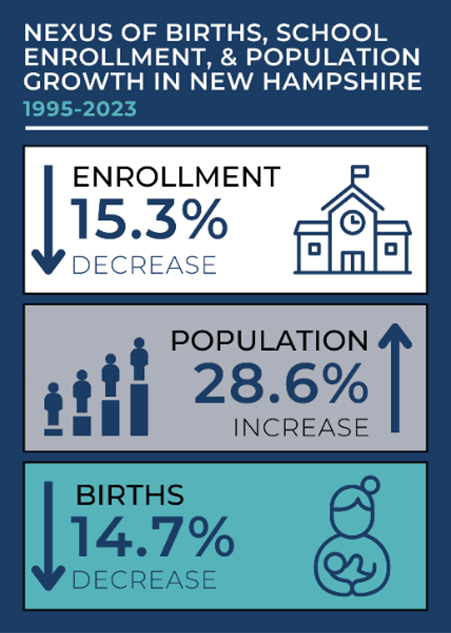-
Home
- News & Events
- New Study Analyzes…
New Study Analyzes the Impact of Housing Development on School Enrollment in Four New Hampshire Communities
September 16, 2024
Analysis by New Hampshire Housing and Urbanomics reveals that new housing generates fiscal benefits for local communities while having little effect on school enrollment.
A new report from New Hampshire Housing, in partnership with Urbanomics, confirms that concerns about new housing development overwhelming school districts are largely unsupported. The study, From Homes to Classrooms: The Relationship Between Housing Development and School Enrollment in New Hampshire, provides an in-depth analysis of school enrollment trends and the fiscal impacts of housing development in four New Hampshire communities from 2014 to 2023.
The relationship between housing development and school enrollment has been debated in New Hampshire for decades. To address these concerns, New Hampshire Housing commissioned Urbanomics to review historical data, assess current school enrollment trends, and analyze the effects of housing growth in Deerfield, Dover, Dunbarton, and Merrimack. The purpose of the study was to determine if there has been a shift in the findings of similar studies conducted over the past 20 years, which consistently showed minimal correlation between new housing and school enrollment growth.
The findings of this report corroborate those of past studies. Despite public concerns that new housing developments might strain school district resources, the study found a continued decline in the number of public school students per housing unit:
- Decline in Student Ratios: Since 1990, the statewide ratio of public school students per housing unit has decreased from 0.39 to 0.29, with even lower ratios found in the four case study communities (0.25 students per unit).
- New Construction Impacts: Housing built between 2014 and 2023 produced 0.16 public school students per unit statewide, with single-family homes showing higher ratios (0.40 students per unit) compared to multifamily rentals and condos (0.06 students per unit).
- Fiscal Benefits: New housing built from 2014 to 2023 generated an average net fiscal benefit of $1,711 per unit for local school districts, while older housing provided a modest net value of $190 per unit.

The study highlights that despite public perception, new housing development has not significantly increased school enrollment. In fact, many communities see a net fiscal benefit from new housing construction. The findings are critical for local governments, school districts, and policymakers as they navigate zoning reforms and balance residential growth with community needs.
“Opposition to new housing is often based on the perception that it will burden communities with the cost of educating more students. However, this study shows that new housing can actually be financially beneficial for municipalities”, said Rob Dapice, Executive Director/CEO of New Hampshire Housing. “The smaller, denser housing types most needed by our residents are the most financially beneficial for towns and cities. We hope that municipal budget committee members across the state will read this report and join the growing number of Granite Staters who recognize that advocating for more housing isn’t just the right thing to do, it’s the smart thing to do.”
The full report, From Homes to Classrooms: The Relationship Between Housing Development and School Enrollment in New Hampshire, is available on NHHousing.org.
About New Hampshire Housing: New Hampshire Housing is a self-supporting public corporation that promotes, finances, and supports housing solutions for the people of New Hampshire. We have helped more than 55,000 families purchase their own homes and been instrumental in financing the creation of more than 16,000 multifamily housing units.
NHHousing.org.

 Sign up for our email list
Sign up for our email list